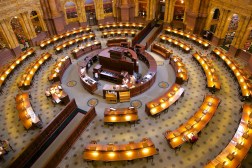Library of Congress launches key module for new copyright records platform

The first public module within the Library of Congress’ new Enterprise Copyright System launched Aug. 1 and lays the foundation for future components intended to support its entire copyright services ecosystem.
Launching the first module, which is known as the Copyright Recordation System (CRS), was the first step in improving and integrating all of the Copyright Office’s technology systems — which also handle copyright registration, public records and internal licensing — into a platform called the Enterprise Copyright System (ECS).
The office is tasked with maintaining records of copyright registration in the U.S., and for more than two years its Office of the Chief Information Officer has worked to replace paper-based processing of copyright ownership transfer requests with a digital submission process.
“What we’re building is really an ecosystem where someone can have an account, and they can actually interact with copyright on multiple services,” Natalie Buda Smith, acting director of digital strategy within OCIO, told FedScoop. “You can register a claim for copyright, you can transfer — all these different activities around it.”
Cloud First development and the use of micro services are key components of the design system used to create the new module.
Buda Smith served as chief of design within the IT Design and Development Directorate for the CRS project, which involved user experience testing early and often. Recordation is a service sought by a specific subset of users when, say, a music catalog is purchased and the rights transferred to a new owner.
“What we’re building is really an ecosystem where someone can have an account, and they can actually interact with copyright on multiple services.”
— Natalie Buda Smith, acting director of digital strategy within the Office of the Chief Information Officer at the Library of Congress
Accenture Federal Services supports the library’s ECS UX project with a small team that includes an interaction and service designer and content strategist. Accenture conducted extensive research and stakeholder workshops before reporting its recommendations in fiscal 2021, and is currently focused on making it easier for content creators, examiners, registration staff and leadership to create, edit, manage and push help content instructing ECS users unschooled in copyright law how to navigate the ecosystem.
“[We created] a single-source-of-truth document, which really helped our content authors store, review and approve help content for each of the application streams that they’re responsible for,” said Jennifer Huppert, visual design manager within AFS’s Digital Studio.
Accenture then used the document to create a prototype for the work detail section of the registration app to optimize components and content.
A separate Accenture team provides quality assurance and testing services and employed virtual users to ensure the CRS app and related servers could handle the traffic expected at launch and beyond.
The Copyright Office started with a small CRS pilot community and scaled to 180 organizations before launch — participants recording more than 8,600 documents — with “a lot” more expected, Buda Smith said. In fiscal 2021, for instance, the office saw nearly 12,000 documents containing titles of more than 950,000 works recorded.
Not only does the recordation system reduce document processing times from several months to weeks, but it features a consistent UX when creating an account or transferring a submission, the ability to ask the Copyright Office questions or engage with it if something is missing, status tracking and notifications, and integrated online payments.
While the Library of Congress has contracts with the big three cloud service providers — Amazon Web Services, Google Cloud and Microsoft Azure — AWS is the sole vendor for CRS.
The Copyright Office continues to add recordation features and plans to incorporate Sections 203 and 305, types of notices of termination, next.
“We don’t see this as a discrete application that we just roll out once and that we look at again in another year,” Buda Smith said. “We use sprints, and we’re constantly improving all these services; so this is a long term program for us.”
Registration, the initiation of a copyright claim, is the “big” module coming in the next few years, she said. But a public records module, letting users look up who owns the rights to a particular work or set, is in beta and on track to become the primary means of searching LoC’s catalog.
A byproduct of the library’s ECS custom design and development work is the onboarding of talent from media companies, consulting firms and other large libraries.
“It’s refreshing in the sense that everyone wants to keep an eye on what’s the latest technology on the horizon,” Buda Smith said. “What’s the best way to work but make it fit for the library?”





